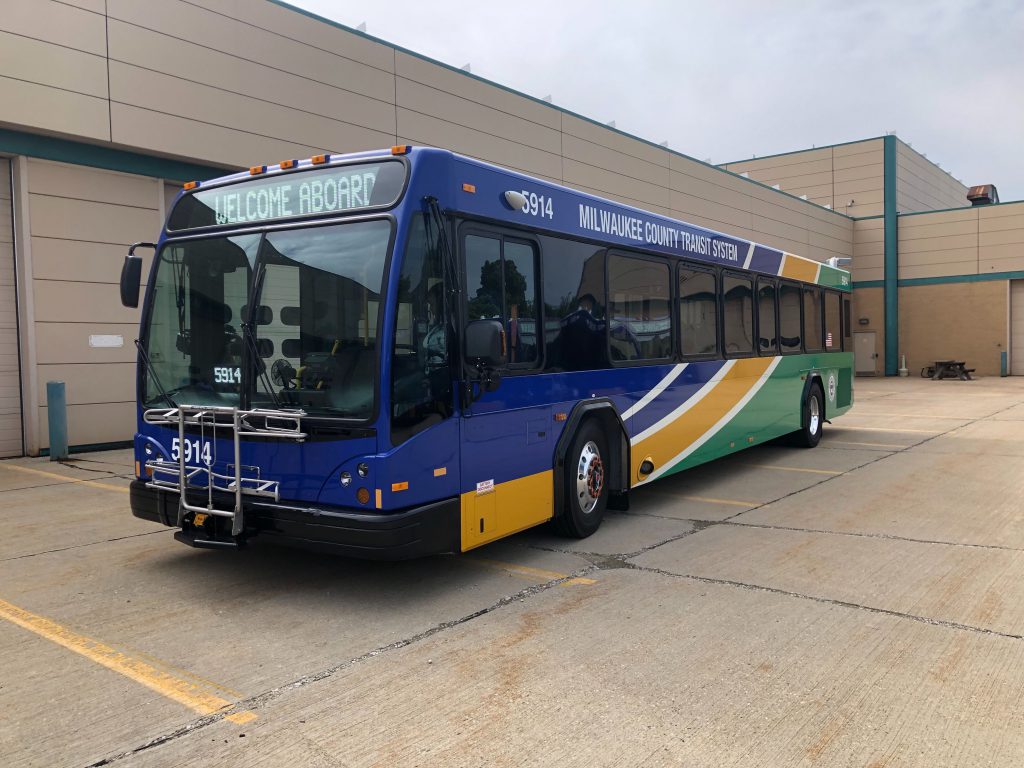Milwaukee Transit in Crisis, Faces Massive Cuts
MCTS faces fiscal cliff as federal grants run out, state aid declines and local revenue is restricted.
The Milwaukee County Transit System (MCTS) would need to eliminate 25% of its service in five years without new or restored funding. According to a new report, the transit system’s annual structural budget deficit could reach $40.5 million, a quarter of its 2023 budget.
The Wisconsin Policy Forum (WPF) report, “Detour Ahead,” models an “optimistic” budget deficit estimate and a “baseline” estimate. Under even the optimistic scenario, MCTS would still be short $17.9 million by 2025 and $28.4 million by 2028. Under a baseline scenario, it will be short $25.7 million by 2025 and $40.5 million by 2028.
In 2008, the last time WPF studied MCTS in detail, the non-partisan think tank issued a similar warning about structural problems within that transit budget that spelled doom for bus service. But in the intervening years, WPF says a combination of “shrewd management” and “good fortune” have forestalled some of the cuts.
“The good fortune included the county’s receipt of federal stimulus funds in 2009 to purchase new buses, as well as MCTS’s receipt of tens of millions of dollars of reprogrammed federal funds from defunct light rail and commuter rail projects,” the report states. “Shrewd management included the restructuring of certain high-ridership routes to allow federal Congestion Management and Air Quality (CMAQ) funds to temporarily pick up their cost and the purchase of fuel at relatively low prices in futures markets. Yet, despite those developments, a controversial $30 VRF was still required in 2017 to avert severe service cuts that year and beyond.”
But the transit system’s largest source of revenue — state transit aid — has not kept pace with annual inflation for most of the past decade and was actually cut by the Republican-controlled Wisconsin State Legislature to offset $32.7 million of the pandemic federal aid. Governor Tony Evers used his discretion with a separate grant to partially restore the cut, but the issue again needs to be addressed in the 2023-2025 state budget.
MCTS’s second-largest funding source is also declining. As ridership has fallen, farebox revenue has also declined. The COVID-19 pandemic accelerated the decline.
And while the transit system has been plugging holes with “shrewd management” and “good fortune,” the report indicates that Milwaukee County has largely been propping the system up on a risky source of federal funds.
The WPF report makes clear that the transit system’s budget troubles are structural and they’ve been papered over with federal funds for years. With less and less state aid, the system is bigger than the county can afford if business continues as usual. Over the next five years, it will need to make cuts to service or raise new revenues, or likely some combination of the two.
The Federal Funding Bandaid
When the COVID-19 pandemic hit and federal stimulus funds were poured into the transit budget to sustain operations, it was not the first time in the past decade that the transit system backfilled its operations budget with federal funds.
For years now the transit system has been using U.S. Department of Transportation aid, called “5307 funds” to support its operations, though the grant funding is supposed to be used for capital expenses, like bus purchases. The federal government has not provided transit operating assistance since the 1990s. But when that assistance disappeared, the report notes, a change in federal law also allowed MCTS to begin plugging the 5307 funds into its operating budget. “This allowed MCTS to use the funds to support fixed route operations, though in doing so it must forsake their usage for bus purchases,” the report states.
In 2018, the transit system had 400 buses. Now it has 321, and 25% are beyond their expected useful life. The lifespan of a bus is considered approximately 12 years and 500,000 miles.
With 5307 funding increasingly dedicated to transit operations, MCTS will have to look to competitive federal grant programs and debt to maintain its fleet. Bus replacement is also becoming more expensive, as the system pursues a transition to an electric fleet with buses that are two to three times up front as expensive as their diesel-burning counterparts.
Ridership Declining
Between 2010 and 2019, MCTS ridership declined by approximately 31%, according to the report. When the pandemic hit in 2020 it dropped from that already diminished level by a further 46%.
Riders have been slowly returning since the pandemic drop, and MCTS budgeted for 2023 to come within 80% of its 2019 ridership level. But the passenger declines over the past decade are being driven by systemic factors, according to MCTS and the WPF report.
“Economic conditions, the rise of ride-hailing, demographic factors, increased access to automobiles through subprime auto loans, and an inability to expand service to emerging employment areas in more dispersed locations because of resource limitations are among the other factors cited by MCTS and other leaders as contributing to declining ridership” are given as decline drivers. The system has also cut service hours since 2010, trimming routes and frequencies.
WPF concludes that even with some recent ridership bounceback, “annual passenger revenue is expected to remain at least $5 million below pre-pandemic levels for the foreseeable future.”
Transit Needs Long-Term, Sustainable Funding
WPF looked at three scenarios to address the budgetary hole. The first was year-over-year cuts to MCTS under a business-as-usual funding assumption. The second was what the WPF calls a “triage approach” that includes a mix of cuts, new revenues and minor cuts. The third scenario involved the state providing Milwaukee County with a sustainable, local funding source.
Under the business-as-usual funding scenario, WPF worked with MCTS on a hypothetical $15 million service cut and found that it would directly impact more than 4,000 daily riders, “impacting and perhaps precluding their ability to get to jobs, medical appointments, etc.”
Under the “triage approach” the county would increase the Vehicle Registration Fee (VRF), or wheel tax, and also shift additional property tax funds toward transit, reducing the magnitude of cuts required. But the county has its own structural deficit to overcome, so any new property tax funds for transit would likely be coming out of another department’s budget. And, according to the report, “unless county leaders are willing to increase the tax levy dedicated to MCTS by [$3 to $5 million annually] or commit to regular VRF increases, the triage approach likely would not be sufficient to avert substantial service reductions after the first year or two.”
Then, there is the long-term funding source, which will need approval from the Republican-controlled Legislature. In 2008, this was imagined as a sales tax dedicated to funding transit. In 2023, there is a real possibility that the county will get a 1% increase in its local-option sales tax, generating an estimated $190 million in annual revenue that the county will split 50/50 with the City of Milwaukee.
Given the county’s structural deficit and its massive maintenance and infrastructure backlog, only a portion of the expanded sales tax would likely be dedicated to transit. And the WPF report predicts that, under a scenario where 10% of new sales tax revenue is dedicated to transit, some elements of the triage approach would likely be necessary, including VRF increases and more property tax funding. The WPF notes that the sales tax is still “uncertain” as is the amount policymakers would dedicate to transit.
“By presenting this approach, however, we are able to show that a long-term solution to the current fiscal crisis is within the grasp of state and local policymakers,” the report states, “and that would particularly be the case if regular, inflationary increases in state operating assistance are added to the state-enabled solution package.”
Read the full report on Urban Milwaukee.
If you think stories like this are important, become a member of Urban Milwaukee and help support real, independent journalism. Plus you get some cool added benefits.
More about the Local Government Fiscal Crisis
- Mayor Johnson’s Budget Hikes Fees, Taxes In 2025, Maintains Services - Jeramey Jannene - Sep 24th, 2024
- New Milwaukee Sales Tax Collections Slow, But Comptroller Isn’t Panicking - Jeramey Jannene - Jun 28th, 2024
- Milwaukee’s Credit Rating Upgraded To A+ - Jeramey Jannene - May 13th, 2024
- City Hall: Sales Tax Helps Fire Department Add Paramedics, Fire Engine - Jeramey Jannene - Jan 8th, 2024
- New Study Analyzes Ways City, County Could Share Services, Save Money - Jeramey Jannene - Nov 17th, 2023
- New Third-Party Study Suggests How Milwaukee Could Save Millions - Jeramey Jannene - Nov 17th, 2023
- Murphy’s Law: How David Crowley Led on Sales Tax - Bruce Murphy - Aug 23rd, 2023
- MKE County: Supervisors Engage in the Great Sales Tax Debate - Graham Kilmer - Jul 28th, 2023
- MKE County: County Board Approves Sales Tax - Graham Kilmer - Jul 27th, 2023
- County Executive David Crowley Celebrates County Board Vote to Secure Fiscal Future and Preserve Critical Services for Most Vulnerable Residents - County Executive David Crowley - Jul 27th, 2023
Read more about Local Government Fiscal Crisis here
MKE County
-
RNC Will Cause Some County Services To Be Moved to Wauwatosa
 Jul 12th, 2024 by Graham Kilmer
Jul 12th, 2024 by Graham Kilmer
-
Hank Aaron State Trail Will Be Closed For RNC, State Fair
 Jul 12th, 2024 by Graham Kilmer
Jul 12th, 2024 by Graham Kilmer
-
MCTS Designing New Bus Shelters
 Jul 10th, 2024 by Graham Kilmer
Jul 10th, 2024 by Graham Kilmer
Transportation
-
MCTS Adds 28 New Buses
 Jul 13th, 2024 by Graham Kilmer
Jul 13th, 2024 by Graham Kilmer
-
MCTS Designing New Bus Shelters
 Jul 10th, 2024 by Graham Kilmer
Jul 10th, 2024 by Graham Kilmer
-
MCTS Updates RNC Bus Detours To Better Serve Downtown, Riders
 Jul 9th, 2024 by Jeramey Jannene
Jul 9th, 2024 by Jeramey Jannene























I don’t know why more people aren’t riding the bus. Gasoline is expensive and seems to go up and down in price regularly. Also, buying a car requires a lot of money (average up to $50,000 currently). Many people are working low-wage jobs nowadays, even college students. How does everyone afford gasoline and the high prices of purchasing both new and used cars nowadays??